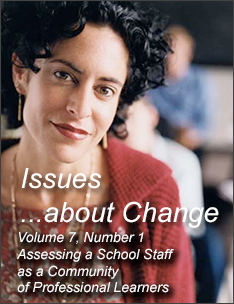Evolution of an Instrument
It would be nice to report that logic and rational thinking prevailed at this juncture. As a matter of fact, it was the angel of inspiration, which descended upon the SEDL researcher. Finding herself on a return trip from Africa with an eight-hour layover in the Cape Town airport, she passed the time by searching a late draft of the literature review for final editorial changes.
Without really thinking about problem solving or a product, she began "messing around" structuring a rubric that would assess the presence or absence of the components of a professional learning community as identified in the review of the literature. The resulting instrument was patterned as an Innovation Configuration matrix or "map" (IC) (Hall & Hord, 1987; Hord, Rutherford, Huling-Austin, & Hall, 1987). In essence, it was designed to assess the existing degree of implementation of the components of a professional learning community in operation in a school staff. The IC orientation provided a measurement of what was actually happening.
With no presumption of noteworthy accomplishment, the newly created instrument made it through customs and to SEDL headquarters in Austin, Texas. As serendipity or synchronicity would have it, however, there was an immediate and additional need for such an instrument. The professional learning community, or community of inquiry and improvement, was a concept that was of interest to others, notably a sister lab, the Appalachia Educational Laboratory (AEL), based in Charleston, West Virginia.
One of AEL's projects proposed to "establish a network and develop a process, both of which will harness the power of collective thinking and collegial learning for continuous improvement in schools" (Meehan, Orletsky, & Sattes, 1997, p. 5). It was believed that some aspects of the AEL project, such as "shared leadership," might be measured by the instrument. A long-standing collegial relationship between SEDL and AEL staff supported the exchange of professional learning community information, including the newly crafted instrument.
The Instrument's Uses
As already noted, a need had developed for identifying school staffs as professional learning communities. An instrument that could be used as a screening, filtering, or assessment tool to ascertain the maturity of staffs as a learning community would be welcomed. With such an instrument, researchers could conduct studies of schools that were clear examples of communities of professional learners, with the goal of learning how a professional learning community is created in a school. Obviously, an inquiry into a mature professional community of learners in a school would yield much information about the school staff's transformation.
Additional uses of the instrument planned by the SEDL project would be as a means to collect baseline data and then to determine if the development of a school staff resulted in a community of professional learners. The instrument could be employed to reveal successful progress along a continuum of development, and to explore the pacing and time required by different schools in different contexts, realizing that not all schools will reach the highest level of development at the same time or at the same rate.
Another application would be to employ the instrument as a diagnostic tool, to be used as efforts are made to create communities of professional learners in other school settings. The external facilitator and/or internal persons at a site could use such formative data as a basis for decision making about the support and assistance needed to move the staff along in its evolution as a professional learning community.
The literature is filled with exhortations about the power and desirability of teachers' working collaboratively. The instrument could facilitate and support studies of how principals (or other campus and district leaders) work with staff and the effects of their efforts on teacher collaboration and efficacy. In addition, other factors, such as context variables, could be correlated with the development of the professional learning community (as indicated by the instrument) within a school.
Finally, the instrument could be used during the continuation period after the establishment of a PLC. An assessment of each of the variables could ascertain whether it remained "robust" in the staff's working arrangements and could provide early warning signals that a part of the PLC was waning and therefore warranted increased attention.
Next Page: Structure of the Instrument

